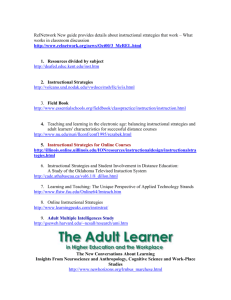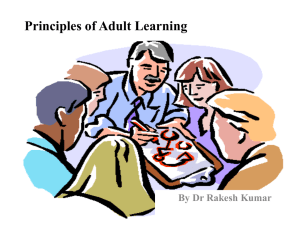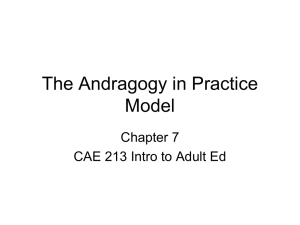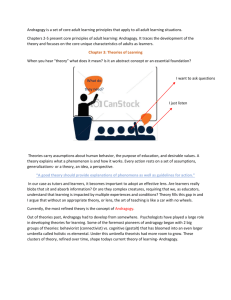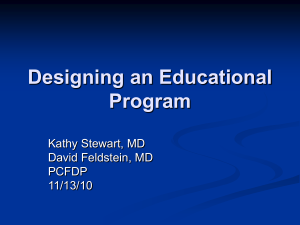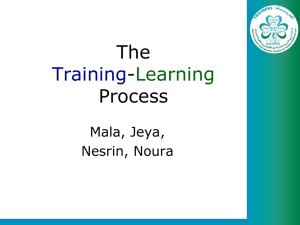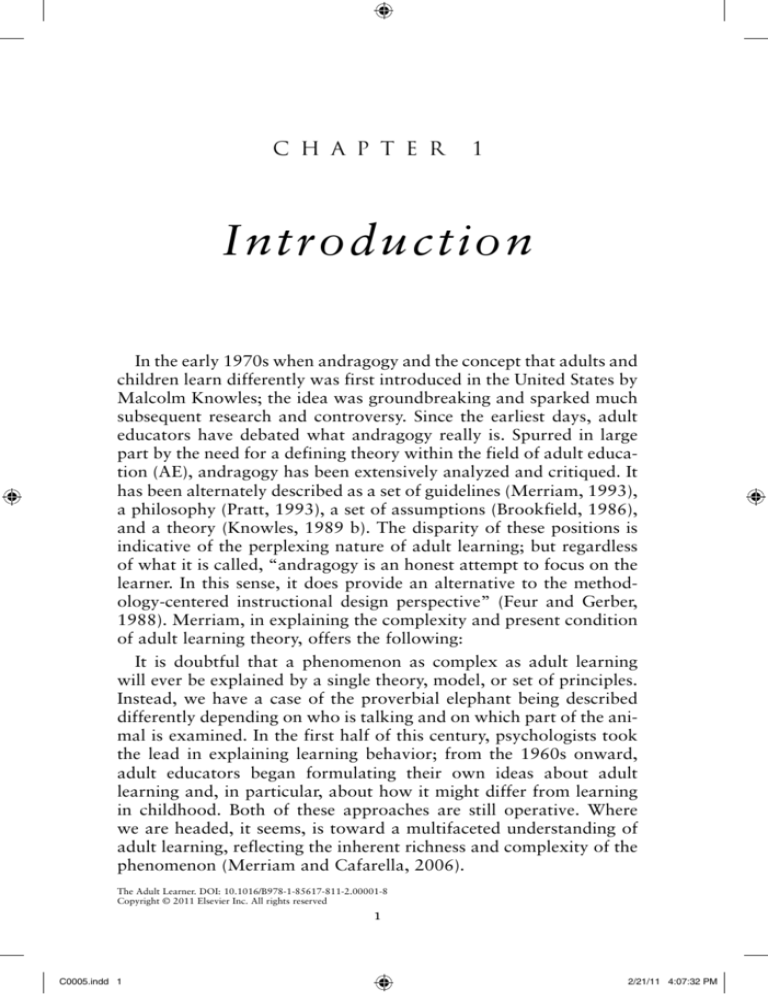
C h a p t e r
1
Introduction
In the early 1970s when andragogy and the concept that adults and
children learn differently was first introduced in the United States by
Malcolm Knowles; the idea was groundbreaking and sparked much
subsequent research and controversy. Since the earliest days, adult
educators have debated what andragogy really is. Spurred in large
part by the need for a defining theory within the field of adult education (AE), andragogy has been extensively analyzed and critiqued. It
has been alternately described as a set of guidelines (Merriam, 1993),
a philosophy (Pratt, 1993), a set of assumptions (Brookfield, 1986),
and a theory (Knowles, 1989 b). The disparity of these positions is
indicative of the perplexing nature of adult learning; but regardless
of what it is called, “andragogy is an honest attempt to focus on the
learner. In this sense, it does provide an alternative to the methodology-centered instructional design perspective” (Feur and Gerber,
1988). Merriam, in explaining the complexity and present condition
of adult learning theory, offers the following:
It is doubtful that a phenomenon as complex as adult learning
will ever be explained by a single theory, model, or set of principles.
Instead, we have a case of the proverbial elephant being described
differently depending on who is talking and on which part of the animal is examined. In the first half of this century, psychologists took
the lead in explaining learning behavior; from the 1960s onward,
adult educators began formulating their own ideas about adult
learning and, in particular, about how it might differ from learning
in childhood. Both of these approaches are still operative. Where
we are headed, it seems, is toward a multifaceted understanding of
adult learning, reflecting the inherent richness and complexity of the
phenomenon (Merriam and Cafarella, 2006).
The Adult Learner. DOI: 10.1016/B978-1-85617-811-2.00001-8
Copyright © 2011 Elsevier Inc. All rights reserved
1
C0005.indd 1
2/21/11 4:07:32 PM
2
INTRODUCTION
Despite years of critique, debate, and challenge, the core principles
of adult learning advanced by andragogy have endured (Davenport
and Davenport, 1985; Hartree, 1984; Pratt, 1988), and few adult
learning scholars would disagree with the observation that Knowles’
ideas sparked a revolution in AE and training (Feur and Gerber,
1988). Brookfield (1986), positing a similar view, asserts that andragogy is the “single most popular idea in the education and training
of adults.” Adult educators, particularly beginning ones, find these
core principles invaluable in the practical challenge of shaping the
learning process for adults.
It is beyond the scope of this introductory book to address the
many dimensions of the theoretical debate raised in academic circles. Our position is that andragogy presents core principles of
adult learning that in turn enable those designing and conducting
adult learning to build more effective learning processes for adults.
It is a transactional model in that it speaks to the characteristics of
the learning transaction, not to the esoteric goals and aims of that
transaction. Thus, it is applicable to any adult learning transaction,
from community education to human resource development (HRD)
in organizations.
Care must be taken to avoid confusing core principles of the adult
learning transaction with the goals and purposes for which the learning event is being conducted. They are conceptually distinct, though
as a practical matter may overlap considerably. Critiques of andragogy point to missing elements that keep it from being a defining theory of the discipline of adult education (Davenport and Davenport,
1985; Grace, 1996; Hartree, 1984), not of adult learning. Grace, for
example, criticizes andragogy for focusing solely on the individual,
and not operating from a critical social agenda or debating the
relationship of AE to society. This criticism reflects the goals and
purposes of the discipline of AE. Human resource development in
organizations has a different set of goals and purposes, which andragogy also does not embrace. Community health educators have yet
another set of goals and purposes that are not embraced.
Therein lies the strength of andragogy: it is a set of core adult learning principles that apply to all adult learning situations. The goals
and purposes for which the learning is offered are a separate issue.
Adult education professionals should develop and debate models of
adult learning separately from models of the goals and purposes of
C0005.indd 2
2/21/11 4:07:32 PM
PLAN
FOR THE
BOOK
3
their respective fields that use adult learning. Human resource development, for example, embraces organizational performance as one
of its core goals; whereas AE focuses more on individual growth.
Having said that, these core principles are also incomplete in terms
of learning decisions. Figure 1-1 graphically shows that andragogy is
a core set of adult learning principles. The six principles of andragogy
are (1) the learner’s need to know, (2) self-concept of the learner, (3)
prior experience of the learner, (4) readiness to learn, (5) orientation
to learning, and (6) motivation to learn. These principles are listed
in the center of the model. As you shall see in this and subsequent
chapters, there are a variety of other factors that affect adult learning
in any particular situation, and may cause adults to behave more or
less closely to the core principles. Shown in the two outer rings of the
model, they include individual learner and situational differences,
and goals and purposes for learning. Andragogy works best in practice when it is adapted to fit the uniqueness of the learners and the
learning situation. We see this not as a weakness of the principles,
but as a strength. Their strength is that these core principles apply to
all adult learning situations, as long they are considered in concert
with other factors that are present in the situation.
This seventh edition of The Adult Learner provides a journey from
theory to practice in adult learning. Figure 1-1 provides a snapshot
summary of considerations within the journey in displaying the six
core adult learning principles surrounded by the context of individual and situational differences, and the goals and purposes of learning. The following chapters will reveal the substance and subtleties
of this holistic model of andragogy in practice.
PLAN
FOR THE
BOOK
The first part of the book, The Roots of Andragogy (Chapters
2–6), presents the core principles of adult learning: andragogy. It
traces the development of the theory, and focuses on the core unique
characteristics of adults as learners.
Part 2, Advances in Adult Learning (Chapters 7–11), addresses
the two outer rings. Chapter 7 discusses in detail the Andragogy in
Practice model introduced in this chapter, and discusses how to apply
it in different settings. Chapter 8 discusses adult learning as practiced
within HRD. Chapter 9 focuses on new thinking about andragogy,
C0005.indd 3
2/21/11 4:07:32 PM
4
INTRODUCTION
ANDRAGOGY IN PRACTICE
(Knowles, Holton & Swanson, 1998)
Goals and Purposes for Learning
Individual and Situational Differences
Andragogy:
Core Adult Learning Principles
3 Prior Experience of the Learner
-resource
-mental models
4 Readiness to Learn
- life related
- developmental task
5 Orientation to Learning
- problem centered
- contextual
Societal Growth
Subject Matter Differences
2 Self-Concept of the Learner
-autonomous
-self-directing
Situational Differences
Institutional Growth
1 Learner’s Need to Know
-why
-what
-how
6 Motivation to Learn
- intrinsic value
- personal payoff
Individual Learner Differences
Individual Growth
Figure 1-1. Andragogy in practice (Knowles, Holton, and Swanson,
1998).
and elaborates on applying the core principles to different learners.
Chapter 10 discusses new advancements in the understanding of adult
learning that enable facilitators to further adapt application of the
core principles. Chapter 11 summarizes these two sections by looking
at the future of andragogy in the areas of research and practice.
C0005.indd 4
2/21/11 4:07:32 PM
REFLECTION QUESTIONS
5
Part 3, Practice in Adult Learning (Chapters 12–19), presents
selected readings that elaborate on specific aspects of andragogy in
practice. These include strategies to implement the core assumptions,
to tailor learning to individual differences, and to implement adult
learning in organizations. Of special interest are two self-assessment
instruments, the Core Competency Diagnostic and Planning Guide
(Chapter 16), and the Personal Adult Learning Style Inventory
(Chapter 17); which enable the reader to begin a personal development journey in adult learning.
REFLECTION QUESTIONS
1.1 What are your general thoughts on how humans learn?
1.2 Based on personal experience, what key factors are related to
adult learning?
1.3 Why is Andragogy in Practice (Figure 1-1) presented as a
holistic learning model?
1.4 If you understood more about how adults learn, how would
you use this information?
C0005.indd 5
2/21/11 4:07:32 PM

